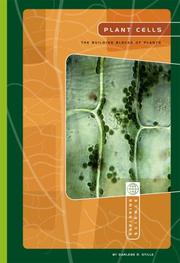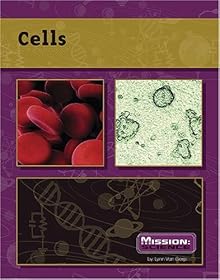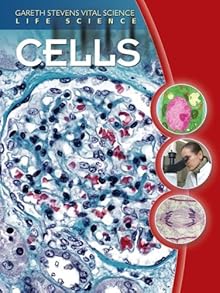In fifth grade, students study cells as part of the living systems unit. Students must understand that organisms are made up of cells, which have defining characteristics that contribute to the organism’s survival (SOL 5.5). This resource set will support instruction during the cell unit.

Plant Cells: The Building Blocks of Plants
Written by Darlene R. Stille and Illustrated by Eric Hoffmann
Plant Cells: The Building Blocks of Plants would serve as a valuable resource for a research project on cells. The book is divided into four clearly defined chapters that address distinct aspects of plant cells. These aspects are the basics, the defining characteristics, the function, and the reproduction of plant cells. Since this book is written at an appropriate reading level, students could read Plant Cells independently in order to collect information for their project. Clear headings and an extensive index create a research-friendly format that will assist students as they search for information related to their topics. Finally, a descriptive glossary and illustrative diagrams support students as they read content-specific vocabulary. Overall, this is an age-appropriate text that enables independent exploration.

Animal Cells: The Smallest Units of Life
Written by Darlene R. Stille and Illustrated by Eric Hoffmann
Animal Cells: The Smallest Units of Life is a good companion resource to Plant Cells. This book explains the vast range of cells, the appearance of animal cells, animal cell functions, and the reproduction of animal cells. Animal Cells specifically emphasizes the impact of cells on all life, from the “smallest ant to the largest elephant.” Stille distinguishes between one-celled and multi-celled organisms. She also explains how the quantity and type of cell affect the life of the organism. For instance, a one-celled bacteria does not posses the same abilities and characteristics as a 60-100 trillion-celled human being. Concrete examples and detailed images will assist students as they read this book. Once again, this resource lends itself toward independent research. Simple diagrams, fun facts, bibliographical resources, and a descriptive glossary combine to create a valuable resource for student research.

Cells
Written by Kimberly Fekany Lee and Designed by Heidi Thompson
Cells is a good resource because it teaches about cells in the context of daily life. This approach supports student comprehension of this difficult topic. For example, the book begins with a description of cells and their size relative to other objects. These descriptions are supported with illustrations of enlarged cells as well as pictures of their size equivalents. For instance, Lee demonstrates the size of human cells relative to a pin head. According to her calculations, one pin head can hold 10,000 human cells. This description concretely conveys the size of a human cell. Cells also explains the various cell organelles and their functions. The differences between the organelles are highlighted through the use of specific examples. For instance, Lee begins by defining the term “ribosome” and explaining its function. She follows up this description with an example that relates ribosomes to the human immune system. Lee explains that prescription antibiotics work by attacking bacteria’s ribosomes. Concrete relationships, such as this one, help students to connect with the content material. This book would serve as an engaging read-aloud for a unit on cells.

Cells and Systems
Written by Holly Wallace and Designed by Celia Floyd
The first four chapters of Cells and Systems focus on cells. This section of the book begins with a simple definition of the term “cell.” Clear illustrations support this definition. Additionally, the author differentiates between animal and plant cells. Two diagrams highlight the defining organelles of each cell type. The second chapter emphasizes the different functions of cell organelles as well as their placement in animal and plant cells. Bold terms, definitions, and exemplary images help readers develop an understanding of the content-specific vocabulary. The third chapter focuses on plant organelles and their role in the plant system. This includes an in-depth view and explanation of chloroplasts, cytoplasm, and stomata. The final cell chapter describes vacuoles and the importance of vascular tissue within plants. Diagrams and photographs outline a plant’s water transport system. These four chapters can be utilized as a read-aloud or as independent reading. Students will benefit from the clear illustrations, simple definitions, and organized layout of this book. Cells and Systems is an approachable text that students can use to develop their background knowledge of cells or to clarify an abstract concept. This resource will help students gain a deeper understanding of cells and their vital role in our lives.

Cells
Written by Darlene R. Stille and Designed by Tammy West
Cells focuses on different cell types. In this book Stille explains cell reproduction and explores the connection between different cell types and life processes. For instance, Stille describes vascular tissue and its vital role in a plant’s transport of water, minerals, and nutrients. Stille also examines the similarities and differences between various cell types. For example, she defines the three types of muscle cells as well as describes their defining features. Due to the extensive nature of this book, the teacher should focus on each chapter individually. Each chapter could serve as an introduction to a lesson on cells. This book could also be used as an independent resource. Students could use this text when researching a specific topic on cells. Through this book, Stille helps students to understand cells’ function and importance in their lives.
Student Resources
- Comparing Plant and Animal Cells: Students can compare plant and animal cells with this interactive model.
- Vascular Plants: This tutorial explains vascular plants through the use of interactive models and grade appropriate descriptions.
- Cell Structure: Students can use this interactive model to recognize the differences between animal and plant cells. Additionally, students will learn about the functions of the organelles in these two cell types.
- Cell Rap: This rap describes the components of animal and plant cells through simplistic rhyme. Its description of organelles and their functions will help students to differentiate between the various organelles and their purposes.
- Cell Practice Test: Students can test their knowledge of animal and plant cells with this comprehensive online test, which is aligned with the Virginia SOLs.
Teacher Resources
- Plant Cell Lab: Through this interactive lab activity students will be able to view and compare plant cells. Students are asked to draw sketches of their observations, answer comprehension questions, and compare and contrast two different cell types.
- Cell Project: This assignment requires students to construct a 3D model of an animal or plant cell. Through creating a cell model students will develop a deeper understanding of cell components. This assignment also includes a rubric and photos of two sample cell models.
- Cell Webquest: This webquest leads students through a guided explanation and exploration of animal and plant cells.
- Cells are the Starting Point: This website provides explanations about cells and their organelles. These explanations are written at a level appropriate for use in interactive notebooks or study guides for fifth grade.
